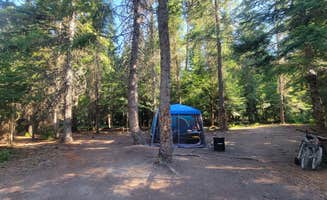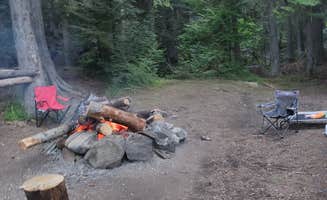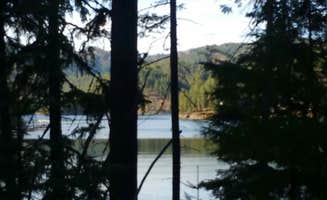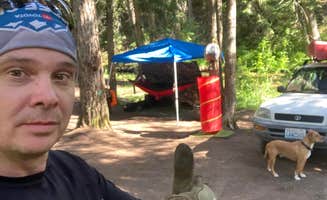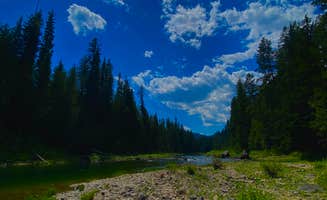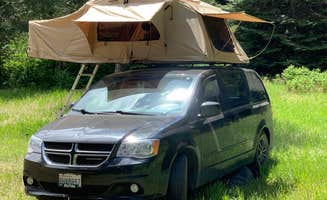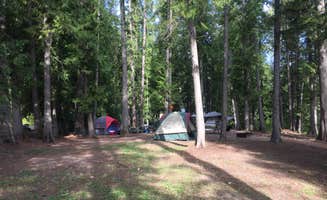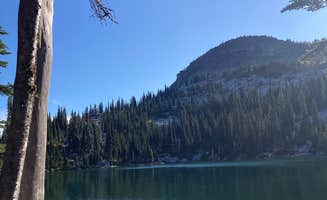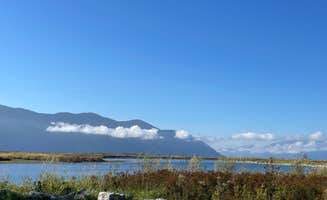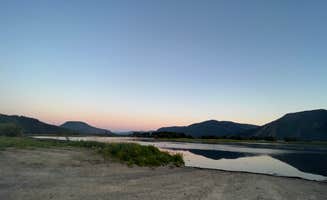Dispersed camping areas near Usk, Washington provide rustic overnight options throughout the Colville National Forest and neighboring wilderness. Sites are often located at elevations between 2,000-3,500 feet with a continental climate that brings warm summers and cold winters. Many primitive sites require navigating unmarked forest service roads, and camping season typically runs from May through October when snow doesn't block access.
What to do
Fishing opportunities: At Little Pend Orielle Campground, rainbow trout fishing from the dock at Potters Pond offers family-friendly angling. As one visitor noted, "There is a family friendly fishing dock on Potters pond, and it is stocked with good sized rainbow trout the little kids had a blast fishing." Larger Bayley Lake nearby offers fly fishing only.
River exploration: Cee Cee Ah Creek provides cooling water access during summer months. According to one camper, "There is a creek that runs through this area, which is great for cooling off on hot days." The small stream offers refreshment without swimming depth.
Alpine hiking: Beehive Lake Dispersed camping rewards those willing to make a challenging trek. One hiker reported, "The hike to get there is pretty strenuous, with some tough climbs along the way. The trail itself isn't well marked, so you'll want to pay close attention or bring a good map to avoid getting off course." Seasonal huckleberry picking adds a sweet reward to the journey.
Waterfall viewing: Drive approximately 20 minutes from Campbell Park at Box Canyon Dam to see Sweet Water Falls. A camper mentioned, "Just up the road is a view point for eagles nest, Sweet Water Falls rest stop, which has a small hike up to a double waterfall!" The short trail leads to impressive cascades.
What campers like
Privacy between sites: North Fork Chewelah Creek offers well-separated camping areas. As one visitor observed, "Nearby campsites are far enough away that you have plenty of privacy." Another camper noted, "We found a great spot to camp but since it was dispersed we made our own fire ring and camped in this area."
Waterside camping: Many appreciate Sullivan creek campground#2 for its creek-adjacent sites. One camper shared, "We stayed at site #7 because the creek runs right by it. It was beautiful, and we loved having our tent right by the water." The sound of flowing water creates natural white noise for sleeping.
Wildlife viewing: Forested settings provide habitat for diverse animals. At Cooks Lake, one visitor reported, "Birds everywhere, woodpeckers in the birch trees and killdeer darting down to the water. Chipmunks and rabbits. Tadpoles and turtles and little water snakes." Evening brings different wildlife: "Bats at night, and the stars!!"
Bear boxes at select sites: Some dispersed sites include bear-resistant storage. At Sullivan Creek, a camper mentioned, "At the site there was a bear box and a fire ring with a moveable grill cover." These metal containers provide secure food storage in bear country.
What you should know
Road conditions vary widely: Many access roads require high-clearance vehicles. At Cooks Lake, a visitor noted, "The road to get there was approx six miles of gravel winding single lane road. But so worth the drive for the beautiful shaded sites and the open Lakeview sites." Another camper warned about getting stuck: "Decided to drive down to the water (that was hardly there) and found myself barely on the edge of lake bottom mud. Didn't get out till the next morning."
Toilet facilities limited: Vault toilets, when available, may not be maintained regularly. One Cooks Lake camper mentioned, "There is a vault toilet that was disgusting, beware." Always bring toilet paper and hand sanitizer as supplies are not provided.
Bear activity common: Wildlife encounters are frequent in this region. A Sullivan Creek camper reported, "Did have a late night bear visitor but was camping in my van so not too concerning." Always properly store food and scented items.
Mosquitoes prevalent near water: Insect repellent is essential, especially in summer. One camper at Little Pend Orielle noted, "We had a lovely view of the pond, which did make the mosquitos quite a nuisance but manageable."
Tips for camping with families
Creek play areas: Shallow water at North Fork Chewelah Creek provides safe places for children. A visitor noted, "First time taking the godson camping and this was the perfect spot. The godson loved it - he even played in the freezing cold water."
Gradual lake entries: Pack River Dispersed Site offers riverside camping with relatively calm water. A camper shared, "On the river and very peaceful." The riverside setting provides natural entertainment for children.
Life jackets available: Some recreation areas provide water safety equipment. At Campbell Park, a visitor observed, "The campground also provides life jackets, if your child needs one!" This adds a safety layer for water activities.
Cave exploration nearby: Families can take cave tours approximately 20 minutes from some camping areas. A camper at Campbell Park mentioned, "About 20 minutes away is Gardner Caves, which is about an hour long cave tour starting at 10am, 12pm, 2pm, and 4pm." These guided tours offer educational opportunities.
Tips from RVers
Smaller trailers only: Most dispersed sites accommodate modest rigs under 25 feet. At Sullivan Creek, one RVer noted, "The size of our site could fit two RVs and several tents (Our pop up tent trailer is 25ft)."
Limited level parking: Finding flat areas for larger vehicles can be challenging. A visitor to Campbell Park at Box Canyon Dam stated, "Parking is level," but this is uncommon at most dispersed sites.
Backing skills required: Tight access roads demand experienced drivers. At Cooks Lake, one RVer advised, "At least 2 of them are good for my trailer although I wouldn't try if you're not experienced with towing."
No hookups available: All sites are primitive with no electric, water, or sewer connections. Pack accordingly with full water tanks and charged batteries for any essential equipment.


